
Back pain statistics are staggering. At any given time, 31 million Americans deal with lower back pain, and it's among the most common reasons people miss work, notes the American Chiropractic Association.
Sitting at a desk all day, poor posture and a sedentary lifestyle are common causes of lower back pain and tightness. And, although regular exercise is one of the best ways to prevent lower back pain, intense activity and weightlifting can sometimes cause stiff and sore back muscles.
Video of the Day
Video of the Day
Easing your back lower back discomfort depends on its cause. Stretching, stabilization and self-massage are among the techniques that can help.
The Truth About Back Pain
When it comes to lower back discomfort, it's often not the lower back at all that's causing the problem. Lots of different muscle groups are connected to the lower back, and when one of those muscles is tight it can pull on the lower back and cause pain.
For example, tight hamstrings are a common cause of low back pain. Sitting all day can cause the hip flexor muscles on the front of your pelvis to become shortened, which can also lead to lower back pain. This is why simply doing lower back stretches, although they may provide temporary relief, isn't the best way to treat your lower back pain and tightness.

Stretch Your Hamstrings
If tight hamstrings are the cause of your pain, regularly stretching the hamstrings with a move such as a seated hamstring stretch may help.
How To:
- Sit on the floor with your legs extended in front of you. Bend your right knee and place the sole of your right foot on the inside of the left thigh.
- Extend the top of your head toward the ceiling, then fold forward over your extended leg. Fold from the hips, instead of rounding the back, to keep a straight spine. Only go as far as you are able to go without rounding the back.
- Place your hands on the floor on either side of your calf or reach for your foot.
- Hold for 20 to 30 seconds, then switch sides.
Stretch Your Hip Flexors
Tight hip flexors cause your pelvis to tilt forward, tightening the muscles of your lower back. Stretch the hip flexors once or twice a day with a kneeling hip flexor stretch for relief.
How To:
- Get down on your right knee with your left knee bent in front of you at a 90-degree angle and your foot flat on the floor.
- Place your hands on your hips and maintain an erect spine.
- Keeping your hip points facing forward, begin to lean forward until you feel a stretch along the front of your right thigh.
- Hold for 20 to 30 seconds, then switch sides.
Stabilize Your Spine
Too much stretching can actually make your lower back discomfort worse. Stabilizing and strengthening your deep abdominal muscles can provide support for the spine and alleviate lower back discomfort. The dead bug exercise provides stabilization.
How To:
- Lie on your back on an exercise mat with your knees bent and your feet flat on the floor.
- Raise your arms straight above your chest. Raise your legs so your thighs are perpendicular to the floor and your shins are parallel to the floor.
- Press your entire back into the floor and contract your abs.
- Lower your right arm toward the floor over your head at the same time as you extend your left leg, not allowing it to touch the floor.
- Keep your core muscles contracted as you bring your arm and leg back to the starting position.
- Extend your left arm and right leg, then come back to center.
- Repeat 10 to 20 times.
Massage Your Back
Massage can help tight muscles release and loosen up a stiff and sore lower back. All you need is a a foam roller.
Place the foam roller under your lower back and place your feet flat on the floor. Using your feet for leverage, roll up and down on the foam roller over the muscles that are tight and tender. When you find a spot that's particularly sore, stop and roll back and forth over the spot. Then move on to the next spot. Do the same thing on each of your hamstrings and gluteal muscles.
Read more: 5 Myths About Back Pain Debunked
Is this an emergency? If you are experiencing serious medical symptoms, please see the National Library of Medicine’s list of signs you need emergency medical attention or call 911.